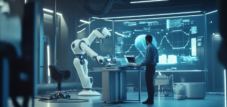Published on: July 8, 2025 / update from: July 8, 2025 - Author: Konrad Wolfenstein

Robot revolution despite the crisis? This is how Ki transforms Germany's factories - and solves our biggest problem - picture: Xpert.digital
Forget old industrial robots: These 3 megatrends are redesigning the future of production
Robotic paradox: Why 14.5 billion euros in sales mean new opportunities-collaborative robots conquer Germany despite the industry crisis
The German robotics and automation industry is currently facing a complex area of tension of economic challenges and technological opportunities. While the industry in 2025 has a decline in sales from ten percent to 14.5 billion euros, groundbreaking opportunities are also revealed by artificial intelligence, collaborative robots and new fields of application that have the potential to fundamentally transform the industrial landscape.
Suitable for:
- The potential for SMEs-AI-controlled robotics for medium-sized companies: transformation of the world of work and new competitive advantages
The current market situation: challenges and structural change
The Association of German Machine and Plant Construction (VDMA) has published sobering figures for 2025, which show a significant deterioration in growth prospects in all sub-sector of robotics and automation. Industrial image processing stagnates with sales of EUR 3.1 billion, while the robotics recorded a decrease of five percent to 3.7 billion euros. The development at Automated Solutions is particularly dramatic, which experience a break -in from 15 percent to 7.7 billion euros.
However, this development is not only due to cyclical demand for demand. The VDMA chairman Dr. Dietmar Ley makes it clear that the downward trend has structural causes, including too much dependence on the German automotive industry and weaknesses in competitiveness. The geopolitical tensions and the increasing competitive pressure from the Far East, especially from China, additionally strengthen this problem.
A particularly worrying development is evident in international competitiveness: China has overtaken Germany in the robot density in the manufacturing trade and is 3rd place with 470 units per 10,000 workers, while Germany fell back to 4th place with 429 units. This shift in global competitive position underlines the urgency of strategic measures to strengthen German robotics and automation industry.
Technological trends and innovations: the way into the future
Despite the current market challenges, technological innovations open up completely new perspectives for robotics and automation. The integration of artificial intelligence is one of the most important megatrends that will change the industry sustainably. Generative AI enables robots to program more intuitively - instead of complex codes, users can communicate with the machines in natural language in the future.
The collaborative robotics experience a remarkable upswing. The market for cobots will grow from $ 3.17 billion in 2023 to over $ 71 billion by $ 2034, which corresponds to an annual growth rate of almost 33 percent. This development is particularly relevant for small and medium -sized companies, since cobots can work directly with people without security fences and can therefore be flexibly integrated into existing production processes.
Another revolutionary trend is the development of humanid robots. Goldman Sachs predicts a volume of $ 38 billion by 2035 for this market, while more optimistic estimates are even up to $ 24 trillion. These systems that can imitate human movements and interactions open up completely new areas of application beyond classic industrial production.
Service robotics: The growth market of the future
The service robotics develop into the most dynamic segment of the robotics industry. With a forecast growth of 19.2 percent annually, the global market of $ 22.40 billion is expected to grow to $ 90.09 billion by $ 2032 in 2024. In Germany, the service market market will grow from EUR 3.72 billion to 5.42 billion euros by 2029 in 2025.
Development in professional service robots is particularly remarkable: sales rose by 30 percent worldwide to over 205,000 units. Transport and logistics dominate with over 113,000 units sold, which corresponds to an increase of 35 percent. This development is largely driven by the shortage of skilled workers, since robot can take over time-consuming tasks such as loading and unloading.
A shortage of skilled workers as the driver of automation
The shortage of skilled workers develops into one of the most important catalysts for robotics and automation. According to the automatica trend index 2025, 75 percent of German employees expect robotics to offer a solution for the shortage of skilled workers. This assessment is not unfounded: by 2030, six million specialists are expected to be missing in Germany.
Automation offers new perspectives, especially for small and medium -sized companies. Studies show that 80 percent of SMEs do not yet have a single robot in operation, although modern automation solutions are increasingly affordable and user -friendly. The development of low-cost robotics and easy-to-use automation makes these technologies attractive for medium-sized companies.
Industry 4.0 and the transformation of production
Industry 4.0 forms the technological foundation for the further development of robotics and automation. The intelligent networking of people, machines and processes creates completely new possibilities of production control. AI-based systems make it possible not only to use robots as programmed machines, but as an adaptive systems that learn from experience and improve it continuously.
The integration of digital twins and edge computing revolutionizes production planning and monitoring. These technologies enable production processes to simulate and optimize production processes in real time without disturbing ongoing operation. Predictive maintenance, which predictive maintenance based on AI analyzes, can cause considerable cost savings because unplanned failures are avoided.
Strategic course: The VDMA action plan 2028
With the strategy paper “Robotics and Automation 2028”, the VDMA has defined concrete goals for the future of the German industry. As a technology leader for industrial robots, Germany should grow faster than the world market by 2028. At the same time, the aim is to achieve a leading position in professional service robotics and to successfully scale them in European and international markets.
The action plan formulates three central demands: more risk capital for start-ups and scale-ups, a roadmap for competitiveness and a targeted focus on the scaling of European innovations. These measures are intended to help reduce the structural disadvantages in international competition and to strengthen Germany as a robotics location.
Market forecasts and future prospects
The long -term market forecasts for robotics are consistently positive. The global robotics market will grow from around $ 25 billion in 2024 to $ 160 to $ 260 billion by 2030. Professional service robots will reach a market share of up to $ 170 billion, while industrial and logistical robots will include around $ 80 billion.
This development is driven by various factors: changing consumer preferences, demand for individualized products and faster delivery times as well as the need to increase productivity despite demographic change. The robot density will continue to increase worldwide, whereby service robotics in particular will record disproportionate growth.
Suitable for:
- Currently the largest humanoid robotics study by Xpert.digital-Marktboom ahead: from robot prototypes to practice
Challenges and solutions
The successful transformation of the German robotics and automation industry requires concerted efforts from politics, business and society. A central problem is the insufficient supply of information in particular of smaller and medium -sized companies about the opportunities and possibilities of robotics. Increased educational and advisory activities are required here.
The financing of automation projects is a hurdle for many companies. Although the prices for robotic solutions are continuously decreasing-humanoid robots have reduced their costs from $ 250,000 to $ 150,000-the initial investments are still considerable. Flexible financing models and state support programs can have a support here.
The role of education and qualification
The transformation to robot-based production requires a comprehensive realignment of the educational and qualification systems. The VDMA calls for the doubling of the courses in robotics and automation at universities as well as mandatory MINT subjects in schools. Continuous training and further training opportunities in companies are essential to prepare the employees for the new requirements.
The acceptance of the robotics among employees is encouraging: 77 percent of German employees support the use of robots in the workplace. The takeover of dangerous, harmful or repetitative activities by robots is particularly valued. This positive basic attitude creates a cheap starting point for further automation.
Sustainability and environmental aspects
The robotics and automation make an important contribution to achieving sustainability goals. By more precise manufacturing processes and optimized resource use, emissions can be reduced and energy efficiency increases. Three quarters of companies see Industry 4.0 a potential to reduce CO₂ emissions.
Automation also supports the production of environmental technologies: robots and automation solutions make it possible to produce photovoltaic systems, heat pumps, fuel cells and electrolysers faster and cheaper. These technologies are crucial for the energy transition and the transition to a sustainable economy.
Dawn of a new era
The German robotics and automation industry is at a turning point. Despite the current market challenges, technological innovations and new fields of application open up enormous opportunities. The integration of artificial intelligence, the development of humanoid robots and the growth of service robotics create completely new opportunities for productivity increases and business models.
The success of this transformation largely depends on whether it is possible to cope with the structural challenges and to implement the technological potential. This requires a coordinated strategy that includes investments in research and development, promoting innovations and the qualifications of the employees.
With almost 49,300 visitors and over 1,100 robots, the Automatica 2025 in Munich impressively demonstrated that the industry is full of innovative strength despite the economic challenges. Robotics and automation remain key technologies for the future viability of the German industrial location - provided that politics and business work determined to set the course for growth and competitiveness.
Suitable for:
Your global marketing and business development partner
☑️ Our business language is English or German
☑️ NEW: Correspondence in your national language!
I would be happy to serve you and my team as a personal advisor.
You can contact me by filling out the contact form or simply call me on +49 89 89 674 804 (Munich) . My email address is: wolfenstein ∂ xpert.digital
I'm looking forward to our joint project.













